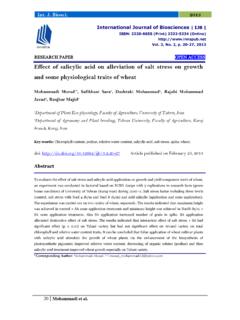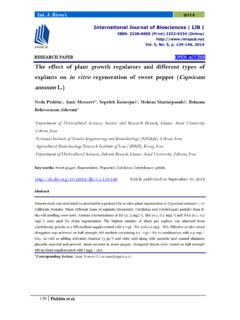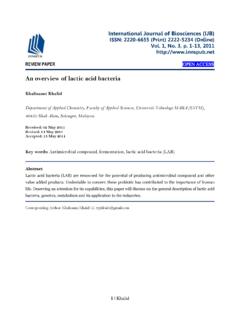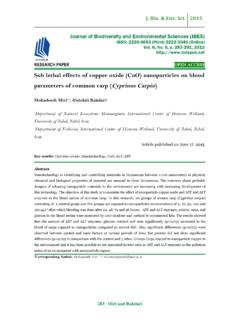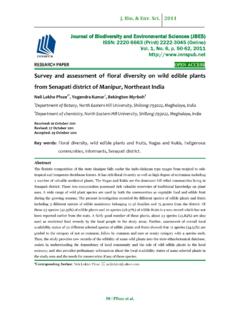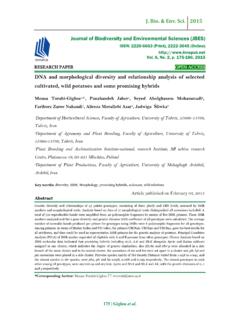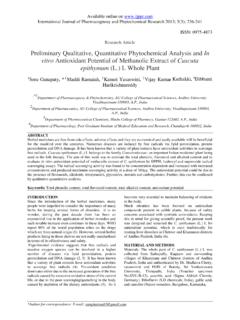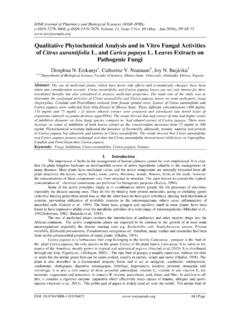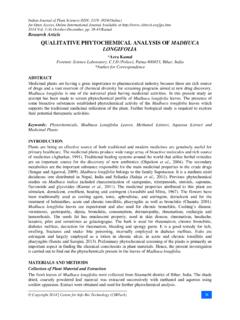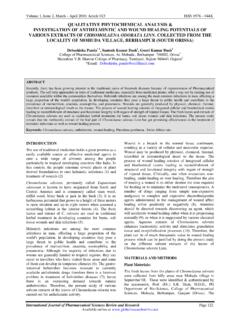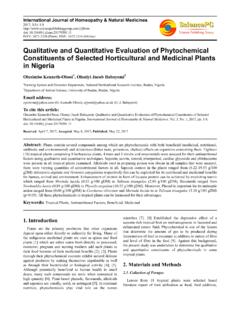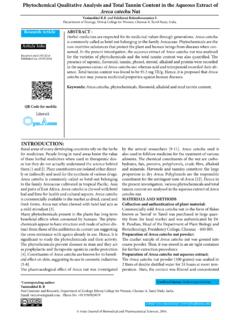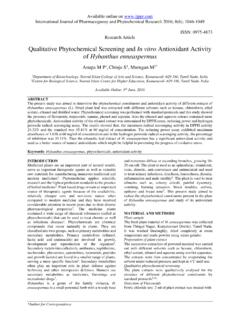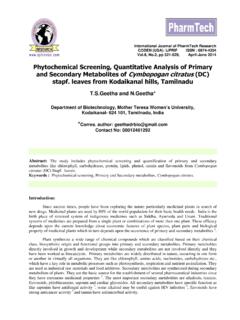Transcription of Qualitative and quantitative phytochemical analysis ...
1 157 Salman et al. Int. J. Biosci. 2015 RESEARCH PAPER OPEN ACCESS Qualitative and quantitative phytochemical analysis , essential element analysis , antibacterial and antifungal activities of leaves of Typha angustata Syed Muhammad Salman1*, Bushra M. Saleem1, Durr e Shahwar2, Shaukat Ali1, Abdul Waheed Kamran3, Saleem Nawaz1 1 Department Of Chemistry, Islamia College University, Peshawar, KPK, Pakistan 2 Department of Zoology, Islamia College University, Peshawar, KPK, Pakistan 3 Department of Chemistry, University of Malakand, Chakdara, Dir, KPK, Pakistan Key words: Typha angustata leaves, phytochemical analysis , essential element analysis , antibacterial and antifungal activities.
2 Article published on October 25, 2015 Abstract Different types of plants in Pakistan can be used as a medicine to cure many diseases. Since a long time ago, the plants have been traditionally used as a medicine due to its medicinal properties. In current study Qualitative analysis of the leaves of Typha Angustata of family Typhaceae were collected which shows the presence of alkaloids, tannins, anthraquinones, glycosides, saponins, terpenoids, flavonoids, phlobotannins, carbohydrates, proteins and reducing sugars while quantitative analysis was carried out which shows that flavonoid, alkaloid and saponin were , and respectively.
3 The results of bio assay suggest that the leaves of Typha Angustata also show antimicrobial potential against gram positive and negative bacterial strains Escherichia coli, Staphylococcus aureus, Pseudomonas aeruginosa and some fungal strains like Aspergillus Niger and Aspergillus Flavus. Similarly some essential elements were analysed by using atomic absorption spectrometer which shows essential elements Ca, Cu, Ni, Cr, Zn, Fe, Mn, Na, and K in different quantities. Moreover, the current research work will help to introduce new and cost effective antibiotic resources and will help to solve the problem of resistance develop by microbes against allopathic antibiotics.
4 * Corresponding Author: Dr. Syed M. Salman International Journal of Biosciences | IJB | ISSN: 2220-6655 (Print), 2222-5234 (Online) Vol. 7, No. 4, p. 157-165, 2015 158 Salman et al. Int. J. Biosci. 2015 Introduction Medicinal plants becoming more important with time due to the presence of potential drug compounds. Due to biologically active compounds like phytochemicals these practically play the role of medicines (Krishnaiah et al., 2009). Phytochemicals have pronounced effect on the human body and combined with the nutrients and fibres they provide shield against certain diseases and conditions of stress (Afolabi et al.)
5 , 2013). More than about 400,000 species of plant has been reported that it possess medicinal properties. Phytochemicals are divided on the basis of function in plants metabolism, into two main categories (Krishna et al., 2009) primary one which include proteins, sugars, amino acids and chlorophyll etc. and secondary one consists Saponins, flavonoids, tannins, terpenoids, alkaloids, essential oils and phenolic compounds etc. ((Krishnaiah et al., 2007; Edeoga et al., 2005). Most of the phytochemicals have shown valuable therapeutic activities such as insecticidal (Kambu et al.)
6 , 1982), antifungal, antibacterial, anticonstipative, spasmolytic, antiplasmodial and antioxidants activities etc.( (Kambu et al.,1982; Lemos et al., 1990; Ferdous et al., 1992; Santos et al., 1998; Benoitvical et al., 2001; Vardar-unlu et al., 2003). Terpenoids exhibit various important pharmacological activities , anti-inflammatory, anti-cancer, anti-malarial, inhibition of cholesterol synthesis, ant-viral and anti-bacterial activities. Terpenoids are very important in attracting useful mites and consume the herbivorous insects. (Kappers IF et al.)
7 , 2005) Alkaloids are used as anaesthetic agents and are found in medicinal plants. (H rouart D et al., 1998). The plants species and herbs suggests the presence of anti-oxidative and antimicrobial constituents in their human body can be protected against pathogens and cellular oxidation reactions by the antioxidant property present in many plant species, so, it is necessary to screened out the different species of the plant for the antioxidant activity. (Clyton et al., 2000). In the treatment of serious gram- negative and gram- positive infections is evident and is most required because of emergence of multidrug resistance in common pathogens, and the potential for use or multidrug resistant agents in bioweapons (Kais et al.
8 , 2013). Typha Angustata is a perennial plant and belongs to family Typhaceae. It is present in the marshes of the temperate regions of the world. The leaves are yellow and green and thick. Its leaves and stem standing straightly. (Clegg, J et al., 1986). The medicinal properties are to cure the nose bleeds, Uterine, Bleeding, Dysmenorrheal and Post-Partum Abdominal Pain. (Yeng Him-Che., 1985). It also has a flavonoid so it can be used as an antioxidant. Plants can be used for the treatment of Alzheimer s disease. (Pavar CR et al., 2011). Plants need different types of elements which are essential for their growth.
9 They need largely Nitrogen, Phosphorus and Potassium as a primary nutrient and these elements are supplied from soil and deficiency of soli can also be avoided by artificial fertilizers as well (Tisdale SL et al., 1993) While the Ca, Mg and S are three secondary nutrients which are required in small quantity and is supplied from fertilizer and Ca and Mg from the limiting materials. Therefore the aim of current study is to perform the Qualitative and quantitative investigation of phytonutrients of locally collected plants Typha Angustata. More ever this work was further extended to determine the antimicrobial activities of ethanolic extracts of this plant against some gram positive and gram negative bacterial as well some fungal strains.
10 (Mahato et al., 1997). Similarly essential elemental analysis was carried by applying atomic absorption spectrometric technique. Material and methods Plant materials Plant leaves were collected from the garden of Islamia College University Peshawar during month of March and April 2014 and identified in department of botany, islamia college university Peshawar. 159 Salman et al. Int. J. Biosci. 2015 Preparation of sample The plant leaves were grinded into powdered form and about of the ground leaves were soaked in ethanol for 48 hours and shaked it occasionally.

